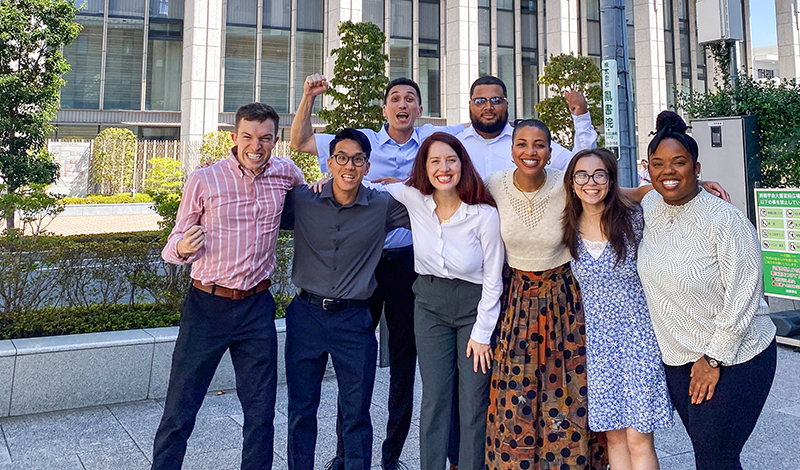Living Buddhism: Hi, Amelia and Shota! Congratulations on attending the 2023 SGI Youth Training Course in Tokyo! We understand you supported one of the meetings at the Hall of the Great for Kosen-rufu behind the scenes. What were your impressions?
Amelia Gonzalez: I’ve never done a Byakuren shift like that before. The Byakuren, Soka Group and Gajokai members who were leading the shift were so serious about treasuring each person. It reminded me of the eight-character passage from the Lotus Sutra, represented by the eight pillars at the Hall: “You should rise and greet [them] from afar, showing [them] the same respect you would a Buddha” (See The Record of the Orally Transmitted Teachings, p. 192). They explained that members might only visit the Hall once in their lifetimes, so they prepare to make it the most uplifting experience for each participant.
In what ways do they prepare for their shift?
Shota Okajima: Leading up to each shift, they study from the “Vigilant Safeguarding” chapter in volume 24 of The New Human Revolution, where Ikeda Sensei writes about the significance of the Gajokai, Soka Group and Byakuren groups. He explains how these groups function to foster in youth division members the spirit to cherish each person who comes to a Soka Gakkai facility or attends an event. In one scene, Sensei runs into Gajokai members patrolling a center close to the Soka Gakkai Headquarters. He joins them for a portion of their shift, and before he leaves, encourages them, saying:
I can’t go along with you on your rounds each time, but in my heart I’m always with you. We share the same mission. Please protect our headquarters in my stead. Protect our culture and community centers. Protect our members. Let’s meet again. (pp. 88–89)
The youth seemed determined to embody Sensei’s heart on each shift to treasure and protect the members.
Amelia: They also explained to us that they share Buddhism with their friends before their shift to ensure that they come to each shift with the expansive life condition of bodhisattvas. They showed us how the high life condition of the youth supporting an activity creates a cheerful atmosphere for everyone.
Those are profound lessons. What was the actual shift like?
Shota: Well, that day, we welcomed members from Kansai, who had either taken the train, bus or drove for many hours to come to the Hall of the Great Vow in Tokyo. We heard they were engaged in a challenging campaign to spread understanding of Buddhism in each community. Even though we didn’t go to Kansai on our trip, by joyfully welcoming the members to the Hall, we felt we could have a positive impact on their campaign.
Amelia: We were stationed inside, just in front of the main prayer room where the meeting occurs. We were lined up to greet the members, and together with the Japanese youth supporting the meeting, said, “Konnichiwa! Omedeto gozaimasu!” which means “Hello! Congratulations!” We made sure that we didn’t miss greeting a single member. Despite being in an air-conditioned building, we were all sweating by the end!
Shota: Yes, I was drenched! I had never fought so hard to greet members. At first, I could tell not every participant was in the best mood, as some may have been tired from the long trip. But when we greeted them, they seemed revitalized.
What an unforgettable experience! How did this impact your view of doing a
behind-the-scenes shift?
Amelia: I want to convey this spirit of treasuring each meeting participant to the Byakuren Group members in SGI-USA. We learned that this determination to cherish each person is the same responsibility that Sensei carries. I also want to reread the “Vigilant Safeguarding” chapter over and over, especially before my own Byakuren shifts, then put what I’ve learned into practice.
After my shift at the Hall, even though I was tired and sweating, I felt so great! I wanted to continue exerting myself for others and felt as if my life had grown in those three hours.
Shota: My challenge is to consider how Sensei would treat the person in front of me. It’s so easy to forget this in daily life, but I feel like in training groups like the Soka Group and Gajokai, we learn how to do this on shift, and the more we do these shifts, the more we can display this spirit in society and truly advance kosen-rufu.
You are reading {{ meterCount }} of {{ meterMax }} free premium articles

